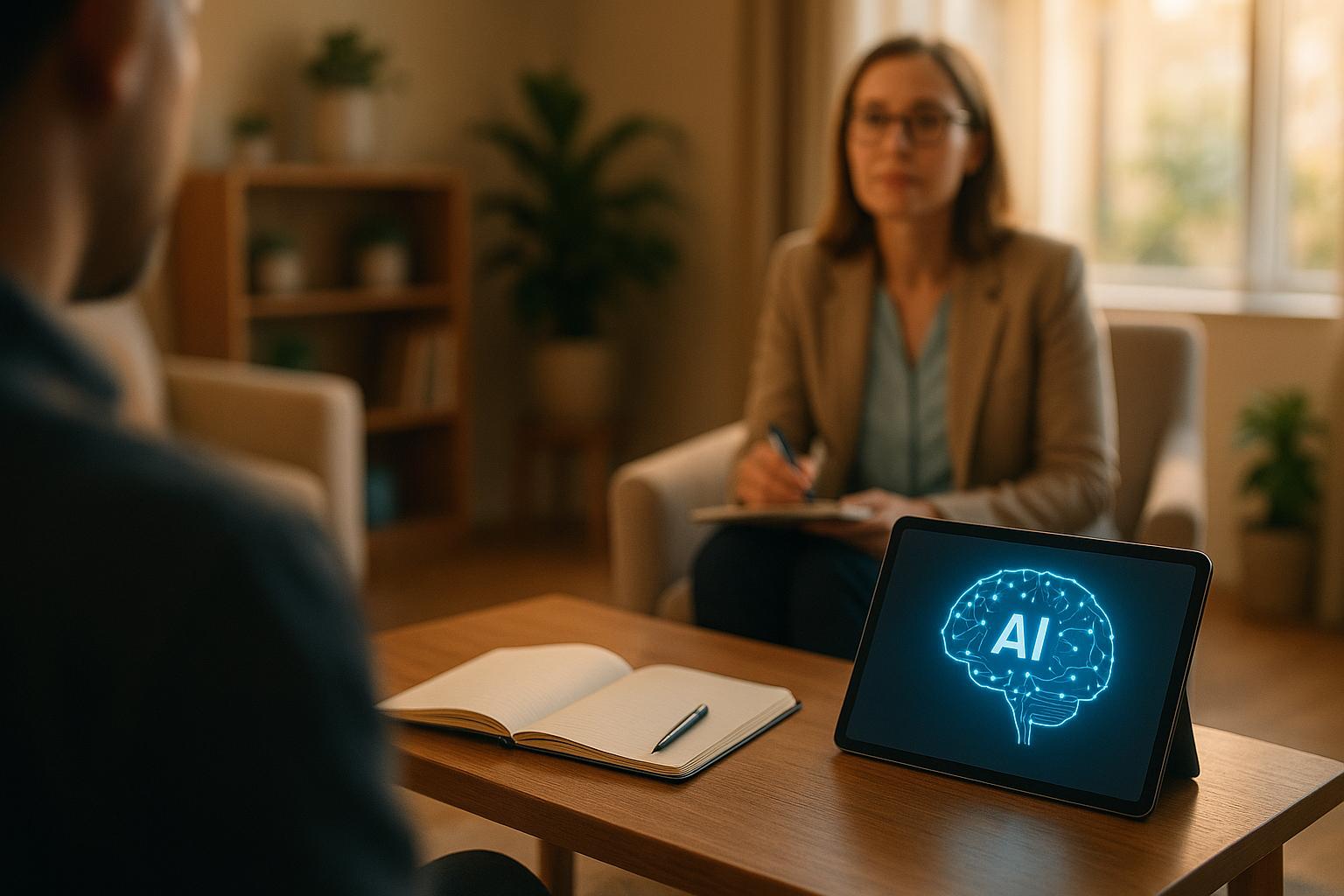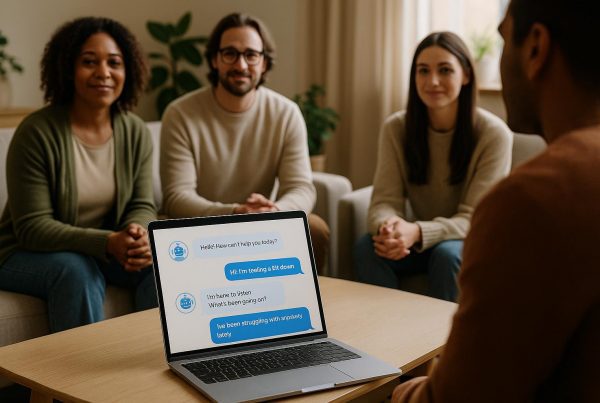Can AI or humans better address mental health biases? The answer lies in combining their strengths. AI offers round-the-clock, affordable, and scalable support, identifying cognitive biases and patterns with precision. Meanwhile, human therapists bring empathy, nuanced judgment, and adaptability to complex situations. Both approaches face challenges – AI struggles with emotional depth and potential data biases, while humans are prone to implicit biases and limited availability. A hybrid model merges AI’s efficiency with human compassion, offering the best path forward for mental health care.
Quick Overview:
- AI Strengths: 24/7 access, lower cost (~$24/month), scalable, data-driven insights, up to 90% diagnostic accuracy.
- Human Strengths: Empathy, flexibility, real-time emotional support, cultural understanding.
- AI Challenges: Lacks human empathy, risks from biased training data, privacy concerns.
- Human Challenges: Costly (~$100–$200/session), limited availability, implicit biases.
| Factor | AI-Driven Approach | Human-Led Approach |
|---|---|---|
| Availability | 24/7, unlimited capacity | Limited hours, appointment-based |
| Cost | ~$24/month | ~$100–$200/session |
| Empathy | Limited | High |
| Bias | Mirrors training data biases | Influenced by implicit biases |
| Scalability | High | Limited |
Takeaway: AI and human therapists work best together. For example, tools like Aidx.ai combine AI’s data-driven insights with human oversight, enhancing both accessibility and empathy in mental health care.
AI-Driven Bias Mitigation: Benefits and Limitations
What AI Systems Can Do
AI tools have reshaped how we identify and address cognitive biases, offering consistent, evidence-based solutions without the fluctuations that come with human factors like mood or personal bias.
Take Aidx.ai’s Adaptive Therapeutic Intelligence (ATI) System™ as an example. It uses techniques like CBT, DBT, ACT, and NLP to detect and respond to cognitive biases in real time. If a user shows signs of catastrophic thinking during a conversation, the system can instantly recognize it and guide them through a cognitive restructuring exercise – offering support precisely when it’s needed.
One of the standout strengths of AI is its ability to analyze data objectively. By examining elements like sentiment, word choice, and conversational patterns over time, these tools can pick up on biases that might otherwise slip under the radar. Studies even suggest AI systems can spot signs of depression or anxiety with up to 90% accuracy [2]. However, this reliance on data and speed can sometimes miss the subtleties of human emotion, leading to mismatched therapy timing.
Aidx.ai also demonstrates how AI can be customized for various needs. Its Incognito mode supports anonymous trauma processing through exposure therapy principles, while Embodiment mode helps users visualize their future selves using somatic alignment techniques. ADHD Focus mode takes a gamified approach, grounded in behavioral activation theory, to tackle attention-related issues. These specialized interventions show the potential for AI to provide scalable and targeted mental health support.
Access and Scale Advantages
One of the biggest advantages of AI in bias mitigation is its accessibility. Available 24/7, these tools provide support during critical moments – whether it’s a stressful situation or an emotional low – when cognitive biases can have the most impact.
Cost is another area where AI shines. Traditional therapy often costs between $100 and $200 per session, making it inaccessible for many. In contrast, platforms like Aidx.ai offer evidence-backed support for about $24 per month, making mental health care more affordable for a wider audience.
The scalability of AI is equally impressive. Personalized interventions can be delivered to thousands of users at the same time, ensuring that help is always available, no matter where or when it’s needed. That said, these benefits come with their own set of challenges and risks.
Problems and Risks with AI Approaches
Despite its strengths, AI-driven bias mitigation isn’t without its flaws. A key limitation is the absence of genuine human empathy. While AI can provide structured exercises, reminders, and nudges, it simply can’t replicate the emotional depth and understanding that form the foundation of a strong therapeutic relationship [4].
Another concern lies in the biases embedded within AI’s training data. If an AI system is trained on biased information, it can unintentionally reinforce and amplify those biases. For instance, a 2019 study by Obermeyer et al. revealed that an AI algorithm used to predict health risks underestimated the chronic illnesses of Black patients compared to White patients at the same risk level. When the algorithm was adjusted, the enrollment of high-risk Black patients nearly tripled – from 17.7% to 46.5% [6].
Beyond bias, AI responses can sometimes feel emotionally off or poorly timed due to the lack of nuanced judgment. Privacy is another pressing issue. Even with GDPR compliance and encryption measures from platforms like Aidx.ai, handling sensitive mental health data always carries the risk of breaches or misuse.
AI also struggles with the complexity and variability of mental health conditions. While some tools boast accuracy rates between 63% and 92% for diagnosing mental illnesses [4], they can fall short in recognizing the subtle nuances that experienced clinicians often catch.
| Risk of AI-Assisted Mental Healthcare | Description |
|---|---|
| Lack of Human Empathy | AI tools can’t provide the emotional connection essential for building trust in therapy. |
| Gaps in Understanding | The complexity of mental illnesses can challenge even the most advanced AI systems. |
| Unpredictability | Errors or unexpected AI behavior can have serious consequences for vulnerable users. |
| Privacy | Sensitive health data is always at risk of being breached or misused. |
| AI Bias | Training data biases can lead to disparities in diagnoses and treatment recommendations. |
Another issue is overreliance on AI without proper human oversight. For instance, one AI-powered tool achieved a 93% accuracy rate in diagnosing eight common mental illnesses [4]. While impressive, that 7% margin still represents real people who could receive harmful or inappropriate advice.
The challenge lies in finding a balance – leveraging AI’s strengths, like its consistency and accessibility, while ensuring the irreplaceable human elements of empathy and judgment remain central to mental health care.
Human-Led Bias Mitigation: Strengths and Weaknesses
Empathy and Flexible Judgment
Human therapists bring a level of empathy that AI simply can’t match. They can interpret body language, pick up on subtle vocal changes, and respond to nonverbal cues in ways that feel deeply personal. This ability to "read the room" allows therapists to adjust their methods on the spot, tailoring their approach to suit the unique needs of each client.
The therapeutic relationship itself becomes a key tool in tackling cognitive biases. When trust and rapport are built, clients feel safe enough to confront difficult thoughts and challenge their own assumptions. For example, a therapist might notice a client falling into all-or-nothing thinking patterns and gently guide them toward more balanced perspectives through thoughtful questioning and reflection.
Human therapists also excel at reviewing their work. By analyzing session notes and recordings, they can spot recurring biases and fine-tune their strategies for each individual. This means that someone grappling with catastrophic thinking might receive entirely different support than someone dealing with confirmation bias.
"Learning to detect and minimize the adverse effects of countertransference, including biases, is a key element of psychotherapists’ professionalization and is essential for establishing safe, empathic, and nonjudgmental environments." – Macdonald and Mellor-Clark [1]
Another strength of human therapists is their ability to adapt in complex situations. They can recognize when factors like personal trauma, cultural influences, or unique circumstances call for a different therapeutic approach. This flexibility allows them to shift between methods as needed. However, while these emotional and intuitive strengths are invaluable, they are often offset by challenges in accessibility and consistency.
Access Barriers
Despite their adaptability, human therapists face significant practical limitations. Therapy can be expensive, and limited session availability makes it difficult for many people to access care [7]. Most therapists work during standard business hours, which poses challenges for individuals with demanding jobs or family responsibilities. Geographic barriers, stigma surrounding mental health, and long waiting lists in urban areas only add to the problem. As a result, fewer than one-third of individuals diagnosed with a mental illness receive treatment, leaving millions without the help they need.
The Problem of Human Bias
Even though human therapists bring empathy and adaptability, they are not immune to bias. As one research team pointed out:
"Human nature confers a vulnerability to biases, blind spots, and self-enhancing illusions, which frequently distort our capacity to make rational sense of ourselves and our environment. Freud would hardly be surprised!" – Macdonald and Mellor-Clark [1]
Studies reveal that at least two-thirds of healthcare providers harbor implicit biases against marginalized groups [8]. These biases can unconsciously shape how therapists perceive, diagnose, and treat clients, potentially undermining the therapeutic process. For instance, a therapist might unknowingly spend less time with certain clients or make diagnostic assumptions based on factors like race or socioeconomic status.
Other human factors, such as professional burnout, memory limitations, and mood fluctuations, can also affect the consistency and quality of care. Addressing these challenges requires ongoing training, supervision, and efforts to build self-awareness among therapists. Recognizing these limitations is a critical step toward improving the effectiveness of human-led therapy.
AI vs. Human Bias Mitigation: Direct Comparison
Side-by-Side Comparison of Key Factors
Let’s take a closer look at how AI and human approaches stack up in addressing cognitive biases in mental health care. Both have their strengths and limitations, and understanding these differences is key to leveraging them effectively.
One of AI’s standout abilities lies in pattern recognition and data analysis. AI systems can sift through massive datasets to detect patterns that might escape even the most experienced human therapists. For example, AI can pick up on mood fluctuations, cognitive distortions, and early psychosis indicators with diagnostic accuracy rates ranging from 63% to 93% for common mental illnesses [4][10]. That’s a level of scale and precision hard to match.
But AI has its limits. When it comes to emotional intelligence and empathy, humans hold the upper hand. A therapist’s ability to connect emotionally, interpret non-verbal cues, and offer genuine compassion is something AI simply cannot replicate. This makes AI better suited as a complement to therapists, rather than a replacement, creating a balance between personalization and scalability [10].
Accessibility and scalability are other areas where AI shines. AI tools are available 24/7 and can serve countless users simultaneously, which is critical in a country where fewer than half of those needing mental health services actually receive them [3]. Additionally, with 76% of individuals from underserved backgrounds owning smartphones [3], AI offers a way to bridge the gap in access to care. On the flip side, human therapists face limitations like scheduling conflicts and geographic barriers.
The bias problem, however, is a shared challenge. AI systems often reflect biases present in their training data, perpetuating societal inequalities tied to race, gender, and socioeconomic status [10]. Human therapists, while often culturally aware, are not immune to implicit biases that can influence their decisions.
| Factor | AI-Driven Approach | Human-Led Approach |
|---|---|---|
| Availability | 24/7 access, unlimited capacity | Limited hours, appointment-based |
| Cost | Lower per-session cost, scalable | Higher cost, often insurance-dependent |
| Pattern Recognition | Processes vast datasets, finds subtle patterns | Relies on experience and intuition |
| Emotional Intelligence | Limited, lacks genuine empathy | High empathy, interprets non-verbal cues |
| Personalization | Data-driven customization | Built on therapeutic rapport |
| Crisis Response | May miss nuanced warning signs | Adapts quickly to emotional changes |
| Bias | Mirrors training data biases | Influenced by implicit assumptions |
| Consistency | Standardized responses | Variable, depends on therapist’s state |
When it comes to crisis response, the difference is stark. Human therapists excel at adapting their communication in real time, offering compassionate and nuanced support during emotionally charged situations [9]. While AI can monitor physiological and behavioral markers, it struggles to interpret the complexities of conditions like PTSD or personality disorders [4].
Personalization is another key distinction. AI customizes interventions by analyzing genetic, environmental, and behavioral data [10]. In contrast, human therapists rely on their intuition and the trust built through direct interaction, creating a deeply personal therapeutic experience.
Accountability also separates the two. When an AI system misdiagnoses or provides ineffective treatment, it raises thorny questions about responsibility [5]. Human therapists, on the other hand, operate within well-established professional accountability frameworks.
The good news? A hybrid approach offers the best of both worlds. Take Aidx.ai’s Practitioner Mode, for example. This tool allows therapists to harness AI’s data-crunching abilities while maintaining the human connection that’s so vital in therapy. Therapists can assign tasks, monitor progress, and stay attuned to their clients’ emotional health in real time. By combining AI’s efficiency with human empathy and judgment, we can create a more effective way to tackle cognitive biases in mental health care.
sbb-itb-d5e73b4
Can AI Replace Therapists? | Psychiatrist Explains
Conclusion: Combining AI and Human Expertise
Addressing cognitive bias in mental health care is no small feat, and neither AI nor human-led methods can tackle it effectively on their own. The real solution lies in blending the strengths of both worlds.
AI offers round-the-clock, scalable support driven by data. It excels at spotting patterns that humans might overlook and delivers interventions like CBT in a way that bypasses barriers like cost or location. However, AI falls short in areas like genuine empathy, emotional intelligence, and cultural sensitivity – qualities that are essential for effective mental health care.
On the other hand, human practitioners bring a level of empathy, critical thinking, and nuanced understanding that machines simply can’t replicate. They provide flexible, compassionate care. But humans are limited by their availability, the high cost of services, and their own susceptibility to unconscious biases.
The future of mental health care lies in hybrid models that combine AI’s precision with the human touch. These systems make the most of AI’s capabilities while ensuring the empathy and adaptability of human therapists remain central.
Take Aidx.ai as an example. Its Adaptive Therapeutic Intelligence (ATI) System™ delivers real-time, evidence-based support using techniques from CBT, DBT, ACT, and NLP. Meanwhile, its Practitioner Mode empowers therapists to track client progress, assign tasks, and maintain meaningful connections between sessions.
This hybrid approach bridges the divide between technology and human expertise. It meets a critical need: while 36% of Americans believe AI could reduce racial and ethnic biases in medicine due to its neutrality, 60% still feel uneasy about health care relying solely on AI [11]. By combining AI’s consistency and accessibility with human oversight, this approach respects both perspectives.
For users, this means immediate, tailored support with the option for human intervention when needed. For therapists, it offers tools to enhance their reach, reduce burnout, and provide better care between sessions.
FAQs
How can AI and human therapists collaborate to improve mental health care?
AI and human therapists can join forces to transform mental health care by leveraging their distinct strengths. AI excels at providing real-time, scalable support, offering personalized insights, and analyzing data to uncover patterns and monitor progress. This frees up therapists to concentrate on delivering empathy, emotional understanding, and tackling complex challenges that require a human connection.
In this partnership, AI can take care of routine tasks like scheduling appointments, sending reminders, and tracking progress. It can also provide users with evidence-based techniques as they need them. Meanwhile, therapists can use AI-generated insights to customize their sessions, ensuring care is tailored and impactful. Together, they create a system that improves accessibility, streamlines processes, and ensures continuous mental health support.
What are the risks of using AI alone for mental health care?
AI has introduced some promising tools for mental health support, but leaning entirely on it comes with its own set of challenges. For one, AI simply can’t replicate human empathy or the deep, nuanced understanding that a trained therapist brings to the table. There’s also the risk of misdiagnosis or algorithmic bias – AI systems might miss important individual differences or fail to consider cultural nuances that are crucial in mental health care. And let’s not forget, technology alone can’t address the intricate human factors that often require a professional’s judgment.
Another pressing issue is privacy. Mental health data is incredibly sensitive, and protecting it is non-negotiable. AI systems are still a work in progress, and they may struggle to identify certain mental health conditions accurately. This could unintentionally reinforce stigma or lead to inappropriate responses. For these reasons, having human oversight is critical to ensure that mental health care remains both safe and effective.
How does AI help reduce bias in mental health care, and what are its challenges?
AI has the potential to make mental health care more inclusive by relying on diverse datasets and techniques like data normalization and anonymization. These approaches aim to limit the impact of biases related to culture, race, or gender, creating a fairer framework for mental health support.
That said, there are still hurdles to overcome. AI systems can unintentionally mirror the biases found in their training data, and they lack the deep empathy that human practitioners bring to the table. Worse, poorly designed AI tools run the risk of amplifying existing societal inequalities. To address these challenges, consistent oversight, ethical development practices, and a strong focus on cultural sensitivity are crucial. These efforts can help ensure AI becomes a positive force in mental health care.



